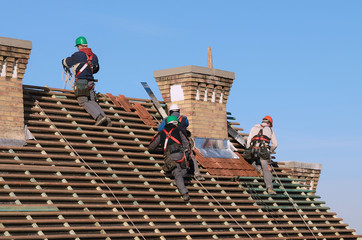Depending on your location, property line regulations may dictate how close a fence can be to neighboring properties or public spaces. This ensures that fences don’t encroach on neighbors or block access to easements and public utility lines.
Some jurisdictions require homeowners to obtain a permit for fencing projects, especially if the fence will be over a certain height. This involves submitting detailed plans and adhering to specific guidelines. If you are not sure what to do, contact Fence Installation Summerville SC.

Zoning Regulations
Depending on where you live, your city may have specific regulations in place that must be followed during the installation of a fence. This can include height restrictions and material requirements. It is important to familiarize yourself with these rules to avoid any legal issues down the road. Additionally, your neighborhood or homeowner association may also have specific guidelines that must be followed.
Many municipalities have zoning regulations that require all fencing to be set back a certain distance from the property line. This is usually to prevent “spite” fences that block the view of an adjoining property or impede access to existing structures such as driveways. Additionally, some municipalities have regulations that restrict the use of certain materials for fences and walls to ensure that they blend with the surrounding community.
It is also important to be aware of any potential laws that regulate the location of a fence near roads and intersections. For example, some cities have a maximum height restriction of three feet for fences located within 15 feet of the corner of a street to prevent them from impeding driver visibility. This is especially important if your home is adjacent to a road or intersection.
If you want to build a fence that will be closer than the maximum permitted distance, you will need to obtain a permit from the building department or zoning board in your municipality. To do so, you will need to submit a copy of your property survey or plot plan and a detailed description of the fence. You will also need to provide an estimate of the cost of construction and proof of insurance.
In some situations, your local zoning ordinance may allow for the exception of these requirements in the case of fences that enclose pools or spas or that are built to contain animals. These types of fences may require a special inspection and may have other stipulations that differ from general residential fencing.
Zoning regulations can vary greatly from one location to the next and it is important to research these rules before beginning any construction project, including fence installation. The best way to do this is to visit your city’s website and search for their zoning ordinance. This document will outline all the rules and regulations that must be followed in your area.
Homeowner Association Rules
HOA rules and regulations often include specific guidelines for fence installation, as well as other aspects of home landscaping and exterior design. These rules may prohibit certain types of materials for fencing or set permitted specifications for fence height. They also may require that homeowners submit a detailed proposal before starting the project, or they might stipulate that all fences must be built by a licensed and insured contractor.
Generally, homeowner association fence regulations stem from concerns about visibility and appearance, such as whether a fence obstructs neighbors’ views of the landscape or prevents them from seeing pedestrians walking or driving through the area. Additionally, some communities have prescriptive easements that protect them from fences erected too close to their property lines.
Another common rule is that fences must be aesthetically pleasing and complement the overall look of the community, so these rules typically include specific restrictions about color and material type. For example, many HOAs only allow white picket fences, so a homeowner’s black metal fence would stick out like a sore thumb in a neighborhood filled with traditional-looking homes.
Finally, some HOAs have setback requirements for fences, which dictate how far from the property line a homeowner can build his or her fence. These requirements are meant to avoid fences that encroach on neighboring property lines and can cause problems with drainage, erosion, or other issues for neighbors.
The best way to keep your HOA happy is by reading the community’s covenant, conditions, and restrictions (CC&Rs) before starting any major projects. These documents will tell you everything from what paint colors are allowed to what type of holiday decorations can go up. They’ll also likely lay out the types of fences that are and aren’t allowed, so you don’t fall in love with a material that isn’t by your HOA’s guidelines.
Fence disputes with neighbors aren’t uncommon, but they can lead to costly legal battles if they aren’t handled properly. It’s important to prioritize open communication with your neighbors and to work together to resolve any disagreements. If you can’t reach a mutually agreeable solution, a qualified real estate attorney can help you resolve the issue through mediation or legal action.
Property Boundaries
The property lines that mark the boundaries of your home and land determine how much space you have to work with for building a fence. Often, these lines are visible and easily identified. However, they may be ambiguous, and it is important to consult with a licensed surveyor to find the exact location of these lines. Surveyors use a variety of methods to establish property lines, including reviewing deed records, and physical evidence, and comparing the location of existing survey markers. In addition, they may consult with neighbors and local government officials to get a better understanding of property boundaries, which can change over time.
State regulations, such as those governing property boundaries, easements, and zoning, play an important role in fence installation. These regulations set guidelines that fence companies must adhere to to avoid legal issues and ensure the safety of their employees and customers. They may also dictate what types of fencing are allowed, as well as the maximum heights and other specifications. In addition, they may stipulate that the fence must be set back a certain distance from the property line, which is known as a setback.
Local governments may also impose their own set of requirements on fence installations, such as required materials and minimum or maximum heights. This information can be obtained from local government records or by contacting the city or town planning department. In some cases, it is necessary to get permission from the property owner before constructing a fence on their land. In addition, local ordinances might address the issue of encroachments on other properties or public rights-of-way.
If a neighbor’s fence encroaches on your property, you must notify them in writing. You may be able to resolve the issue by discussing it with your neighbor and agreeing to a solution or, in more serious cases, pursuing legal action.
As a general rule of thumb, it is best to build fences at least two to eight inches away from your property line. This helps to prevent future disputes and maintain good relationships with your neighbors.
Building Permits
Like many home projects, fences might require a building permit from your local township. The process of obtaining these permits varies widely from place to place. Some places require no permits or notification, while others might ask for sketches, plans, photographs, and fees in addition to zoning regulations and homeowner association rules. Some communities also have a requirement that you notify neighbors of your intention to build a fence, which is intended to prevent property line disputes.
Defining your property lines accurately is a crucial step in the fence installation process. This will ensure that your fence does not encroach on neighboring property and is not located near a utility line or other public access point, which could cause safety concerns for pedestrians and drivers. If you are unsure of your property lines, consult official records or have a land survey conducted by a licensed professional.
Zoning regulations might also set requirements for the height of your fence and for how close it can be to structures like houses, roads, or sidewalks. This will be an important consideration when choosing your fence materials and location, as the wrong material or height can result in a fine or even the need to remove the structure.
If your municipality has a “prescriptive easement” law, this might also limit how close you can put your fence to the boundary with your neighbor’s property. This law is typically based on how long your neighbor has been using a particular part of their land for a specific purpose, and it may prohibit you from interfering with that use with your new fence.
Finally, some municipalities will have inspections during the construction of your fence to make sure that it is being built according to specifications and meets all code and zoning requirements. Before starting your project, be sure to contact 811 call-before-you-dig to have any underground utilities marked so that they can be avoided during the construction of your fence. This is a good way to avoid costly damage and inconvenience to yourself, your neighbor, or your neighborhood.

